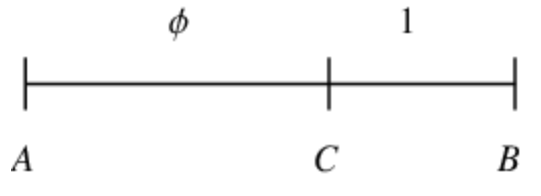| Line 3: | Line 3: | ||
<center> <math> \frac{a+b}{a} = \frac{a}{b} </math> </center> | <center> <math> \frac{a+b}{a} = \frac{a}{b} </math> </center> | ||
| + | |||
| + | After solving for the ratio itself (discussed in the calculations section), we can find that the golden ratio is: | ||
<center> <math> \frac{1 \pm \sqrt{5}}{2} = \phi </math> </center> | <center> <math> \frac{1 \pm \sqrt{5}}{2} = \phi </math> </center> | ||
Revision as of 17:44, 2 December 2018
Introduction
The golden ratio is a ratio such that, given two quantities a and b,
After solving for the ratio itself (discussed in the calculations section), we can find that the golden ratio is:
The golden ratio, $ \phi $, is sometimes also called the golden mean or the golden section. The golden ratio can be frequently observed in man-made objects, though they are generally “imperfectly golden” – that is, the ratio is approximately the golden ratio, but not exactly. Some everyday examples include: credit cards, $ \frac{w}{h}=1.604 $, and laptop screens, $ \frac{w}{h}=1.602 $ (Tannenbaum 392).
Visualizations of the golden ratio can be seen below (Weisstein):
MathIsFun also has an interactive display that can construct a rectangle in the golden ratio given a certain fixed width or length.



